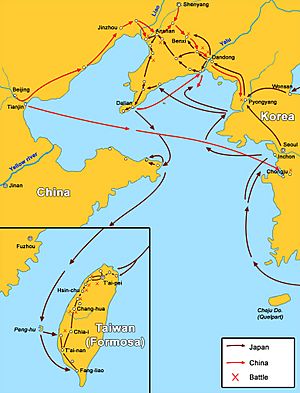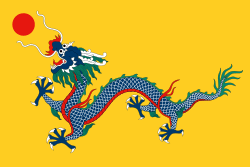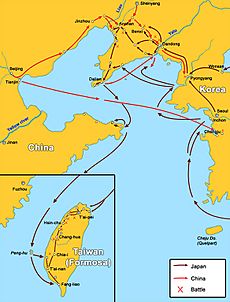First Sino-Japanese War facts for kids
Quick facts for kids First Sino-Japanese War |
|||||||||
|---|---|---|---|---|---|---|---|---|---|
 Japanese troops during the Sino-Japanese war  First Sino-Japanese War, major battles and troop movements |
|||||||||
|
|||||||||
| Belligerents | |||||||||
| Commanders and leaders | |||||||||
| Strength | |||||||||
| 630,000 men Beiyang Army Beiyang Navy |
240,000 men Imperial Japanese Army Imperial Japanese Navy |
||||||||
| Casualties and losses | |||||||||
| 35,000 dead or wounded | 1,132 dead, 3,973 wounded 11,894 died of disease |
||||||||
The First Sino-Japanese War was a major conflict between the Qing Dynasty of China and the Empire of Japan. It took place from August 1, 1894, to April 17, 1895. Japan won the war, which led to big changes in Asia. After the war, both sides signed the Treaty of Shimonoseki in 1895. This treaty gave Japan new lands and influence.
Contents
Military Strengths
Before the war, both China and Japan had large armies and navies. However, they had different strengths and weaknesses.
China's Military
China's military was known as the Qing Empire forces. They had a very large army, with about 630,000 soldiers. Their main naval force was the Beiyang Fleet. Important commanders included Li Hongzhang and Ding Ruchang.
The Beiyang Fleet was China's strongest naval group. It had 25 warships. The most powerful ships were the Dingyuan and Zhenyuan. These ships were very large and strong. However, the fleet faced problems. Money meant for the navy was sometimes used for other things. This meant the ships did not always have the newest weapons or enough training.
Japan's Military
Japan's military was called the Imperial Japanese Army and Imperial Japanese Navy. They had about 240,000 soldiers ready for war. Their navy had 32 battleships and 24 smaller torpedo boats. Key commanders were Yamagata Aritomo and Itō Sukeyuki.
The Japanese military was well-equipped. They had invested in modern weapons and training. Their ships were often newer and faster than China's. This gave them an advantage in battles.
Key Battles of the War
The war involved several important battles on land and at sea. These battles decided the outcome of the conflict.
Battle of the Yalu River
This was a major naval battle. It happened on September 17, 1894, near the Yalu River. This river forms part of the border between China and Korea. The Beiyang Fleet of China fought against the Imperial Japanese Navy.
The battle lasted for about five hours. China's Beiyang Fleet lost four battleships. About 1,000 Chinese soldiers were killed. The Japanese navy lost only one battleship. After this defeat, the Chinese commander, Ding Ruchang, moved his ships back to the port of Lushun.
Battle of Lushunkou
After the naval battle, Japanese armies moved onto land. On September 17, 1894, they captured important forts and cities in Lushun and Dalian. These places had strong cannons.
Sadly, after taking the cities, Japanese troops harmed many Chinese civilians. This event is known as the Port Arthur massacre. It was a very tragic part of the war.
Battle of Weihaiwei
In January 1895, the Japanese armies attacked Weihaiwei. This was another important port where the Beiyang Fleet was based. The Beiyang Fleet was badly defeated in this battle. Eleven of their battleships were captured by the Japanese forces. This loss was a major blow to China's navy.
After the War
Japan's victory in the First Sino-Japanese War had big consequences. China lost its influence over Korea, which became independent. China also had to give up Taiwan, the Penghu islands, and the Liaodong Peninsula to Japan. This war showed that Japan was becoming a strong power in Asia.
Images for kids
-
Woodblock print depicting the flight of the Japanese legation in 1882
-
The French-built Matsushima, flagship of the Imperial Japanese Navy during the Sino-Japanese conflict
-
Empress Dowager Cixi built the Chinese navy in 1888.
-
Japan–China peace treaty, 17 April 1895
-
Satirical drawing in the magazine Punch (29 September 1894), showing the victory of "small" Japan over "large" China
See also
 In Spanish: Primera guerra sino-japonesa para niños
In Spanish: Primera guerra sino-japonesa para niños



















